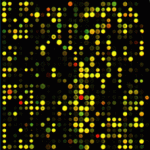Genomics
|
25 november 2015 07:34:33 |
| Whole genome annotation and comparative genomic analyses of bio-control fungus Purpureocillium lilacinum (BMC Genomics) |
|
Tweet Background:
The fungus Purpureocillium lilacinum is widely known as a biological control agent against plant parasitic nematodes. This research article consists of genomic annotation of the first draft of whole genome sequence of P. lilacinum. The study aims to decipher the putative genetic components of the fungus involved in nematode pathogenesis by performing comparative genomic analysis with nine closely related fungal species in Hypocreales.
Results:
de novo genomic assembly was done and a total of 301 scaffolds were constructed for P. lilacinum genomic DNA. By employing structural genome prediction models, 13, 266 genes coding for proteins were predicted in the genome. Approximately 73 % of the predicted genes were functionally annotated using Blastp, InterProScan and Gene Ontology. A 14.7 % fraction of the predicted genes shared significant homology with genes in the Pathogen Host Interactions (PHI) database. The phylogenomic analysis carried out using maximum likelihood RAxML algorithm provided insight into the evolutionary relationship of P. lilacinum. In congruence with other closely related species in the Hypocreales namely, Metarhizium spp., Pochonia chlamydosporia, Cordyceps militaris, Trichoderma reesei and Fusarium spp., P. lilacinum has large gene sets coding for G-protein coupled receptors (GPCRs), proteases, glycoside hydrolases and carbohydrate esterases that are required for degradation of nematode-egg shell components. Screening of the genome by Antibiotics & Secondary Metabolite Analysis Shell (AntiSMASH) pipeline indicated that the genome potentially codes for a variety of secondary metabolites, possibly required for adaptation to heterogeneous lifestyles reported for P. lilacinum. Significant up-regulation of subtilisin-like serine protease genes in presence of nematode eggs in quantitative real-time analyses suggested potential role of serine proteases in nematode pathogenesis.
Conclusions:
The data offer a better understanding of Purpureocillium lilacinum genome and will enhance our understanding on the molecular mechanism involved in nematophagy. |
| 111 viewsCategory: Genomics |
 Replicate exome-sequencing in a multiple-generation family: improved interpretation of next-generation sequencing data (BMC Genomics) Replicate exome-sequencing in a multiple-generation family: improved interpretation of next-generation sequencing data (BMC Genomics)Comprehensive characterization of a time-course transcriptional response induced by autotoxins in Panax ginseng using RNA-Seq (BMC Genomics) 
|
| blog comments powered by Disqus |
MyJournals.org
The latest issues of all your favorite science journals on one page
The latest issues of all your favorite science journals on one page



